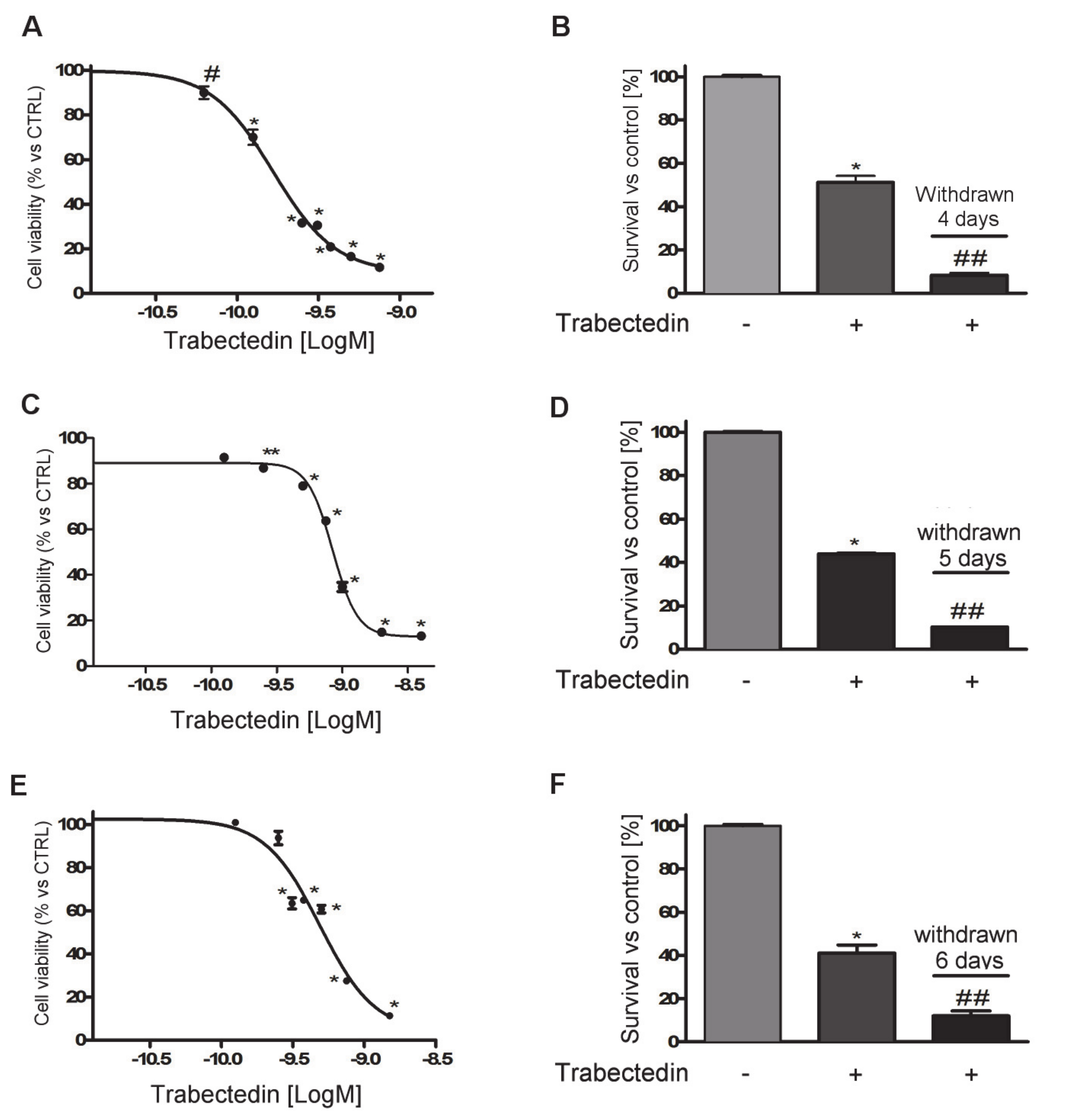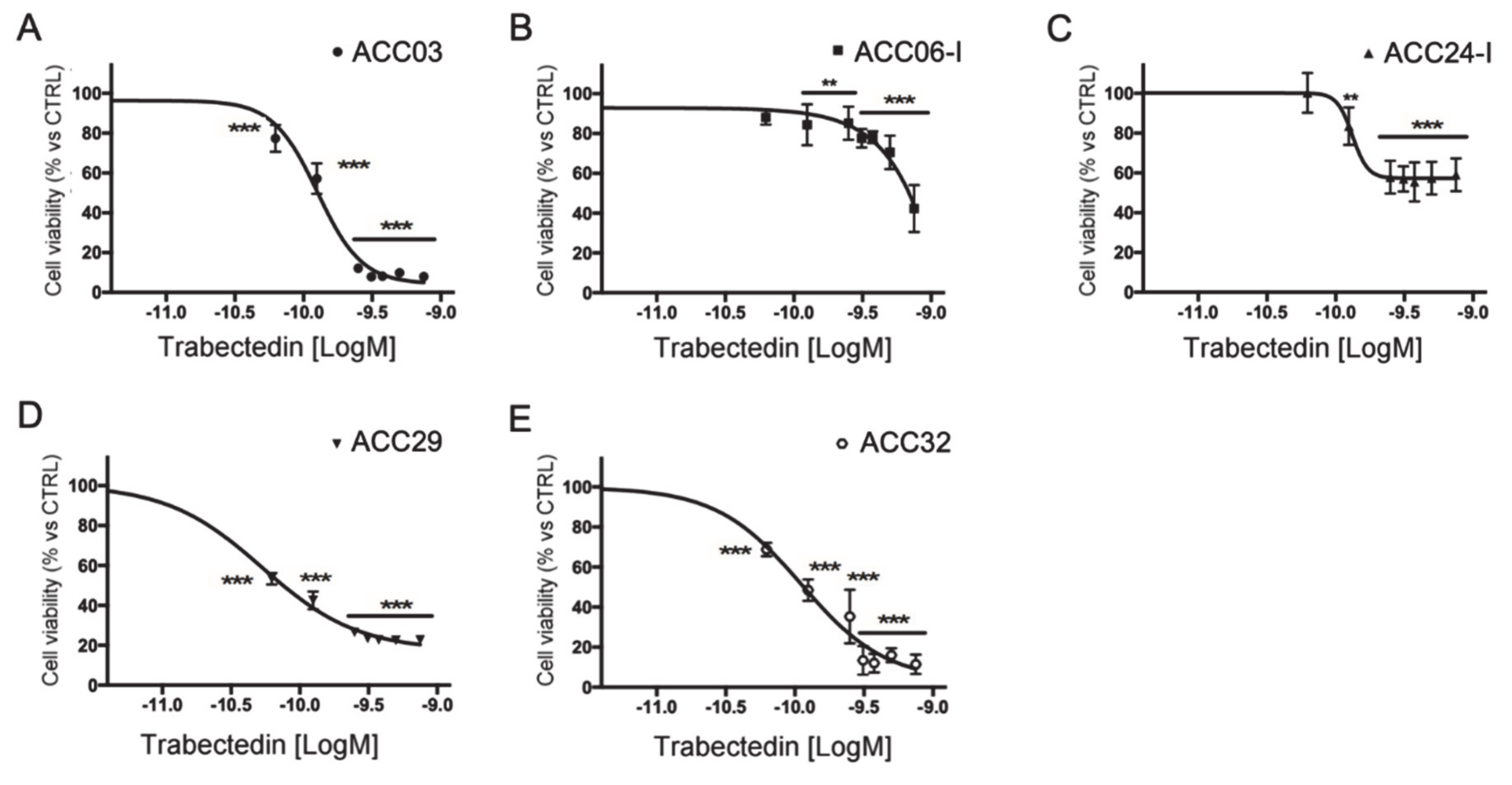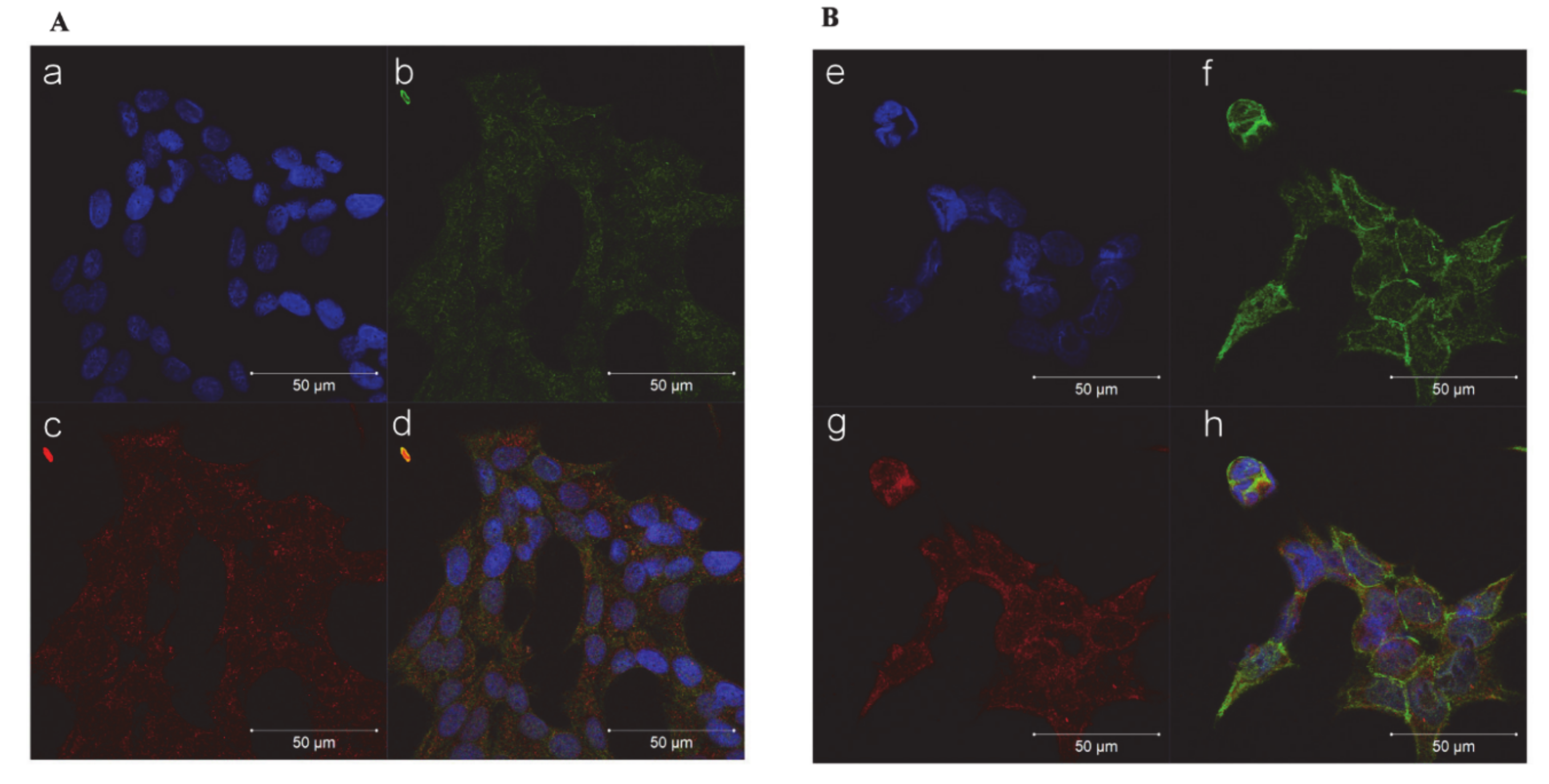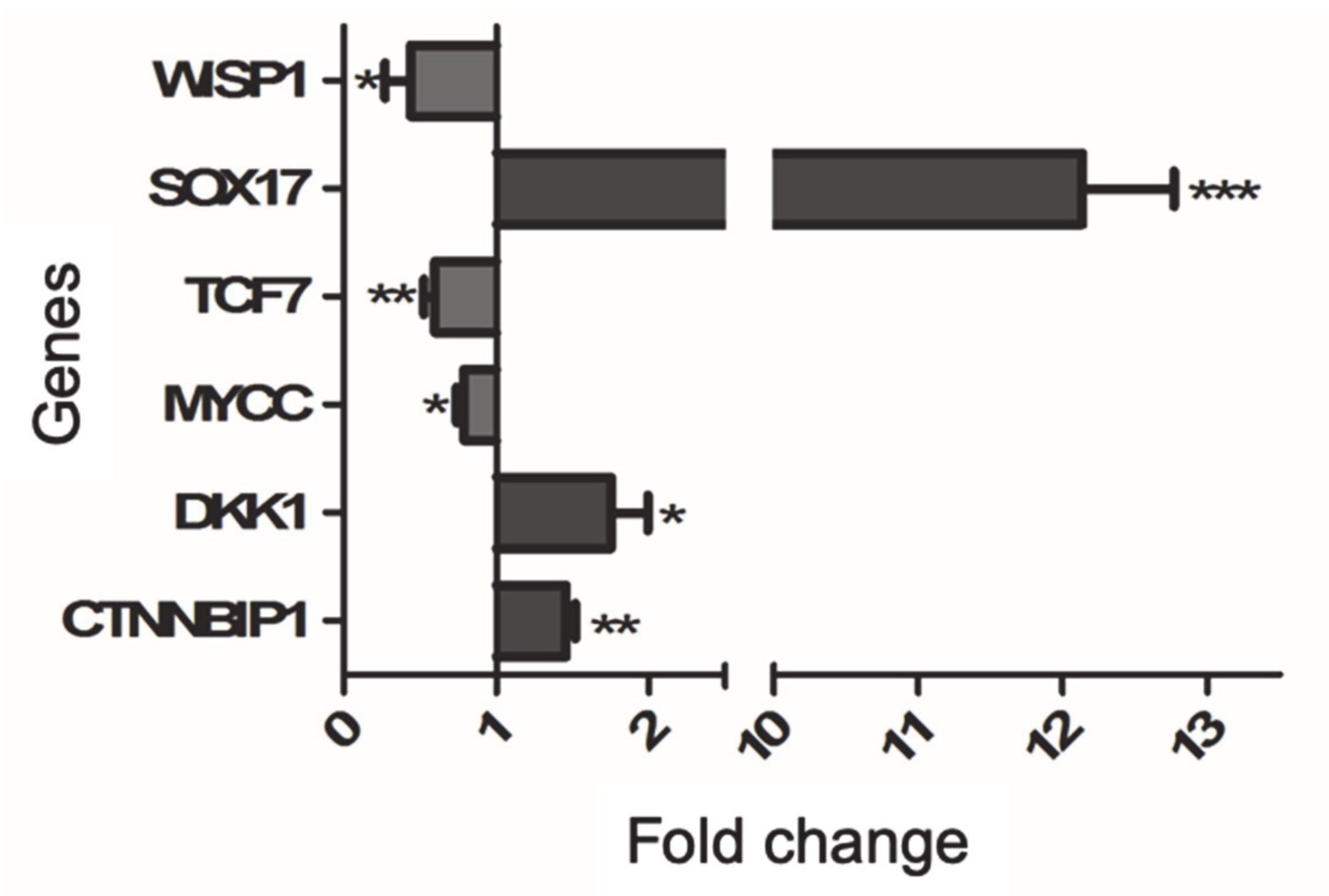Cytotoxic Effect of Trabectedin In Human Adrenocortical Carcinoma Cell Lines and Primary Cells
Abstract
1. Introduction
2. Results
2.1. Trabectedin Induced Cytotoxicity in ACC Cell Lines
2.2. Trabectedin-Induced Cytotoxicity in ACC Primary Cell Cultures
2.3. Trabectedin Enhanced Cytotoxicity Induced by Mitotane in NCI-H295R Cell Line
2.4. Trabectedin Affects β-catenin Localization in NCI-H295R Cell Line
2.5. Trabectedin Affects the Expression of β-catenin Target Genes
3. Discussion
4. Materials and Methods
4.1. Cell Lines
4.2. Primary Cultures
4.3. Cell Viability Assay
4.4. Cell Treatments
4.5. Drug Combination Experiments
4.6. Quantitative RT-PCR (qRT-PCR)
4.7. WNT/β-catenin Pathway Gene Profile
4.8. Western Blot
4.9. Immunofluorescence
4.10. Chemicals
4.11. Statistical Analysis
5. Conclusions
Supplementary Materials
Author Contributions
Funding
Conflicts of Interest
References
- Terzolo, M.; Daffara, F.; Ardito, A.; Zaggia, B.; Basile, V.; Ferrari, L.; Berruti, A. Management of adrenal cancer: A 2013 update. J. Endocrinol. Invest. 2014, 37, 207–217. [Google Scholar] [CrossRef] [PubMed]
- Fassnacht, M.; Dekkers, O.; Else, T.; Baudin, E.; Berruti, A.; de Krijger, R.R.; Haak, H.R.; Mihai, R.; Assie, G.; Terzolo, M. European Society of Endocrinology Clinical Practice Guidelines on the Management of Adrenocortical Carcinoma in Adults, in collaboration with the European Network for the Study of Adrenal Tumors. Eur. J. Endocrinol. 2018, 179, G1–G46. [Google Scholar] [CrossRef] [PubMed]
- Waszut, U.; Szyszka, P.; Dworakowska, D. Understanding mitotane mode of action. J. Physiol. Pharmacol. 2017, 68, 13–26. [Google Scholar] [PubMed]
- Micromedex® (electronic version). IBM Watson Health, Greenwood Village, Colorado, USA. Available online: https://www.micromedexsolutions.com/ (accessed on 31 October 2019).
- Berruti, A.; Terzolo, M.; Sperone, P.; Pia, A.; Della Casa, S.; Gross, D.J.; Carnaghi, C.; Casali, P.; Porpiglia, F.; Mantero, F.; et al. Etoposide, doxorubicin and cisplatin plus mitotane in the treatment of advanced adrenocortical carcinoma: A large prospective phase II trial. Endocr. Relat. Cancer 2005, 12, 657–666. [Google Scholar] [CrossRef] [PubMed]
- Fassnacht, M.; Terzolo, M.; Allolio, B.; Baudin, E.; Haak, H.; Berruti, A.; Welin, S.; Schade-Brittinger, C.; Lacroix, A.; Jarzab, B.; et al. Combination chemotherapy in advanced adrenocortical carcinoma. N. Engl. J. Med. 2012, 366, 2189–2197. [Google Scholar] [CrossRef]
- Sperone, P.; Ferrero, A.; Daffara, F.; Priola, A.; Zaggia, B.; Volante, M.; Santini, D.; Vincenzi, B.; Badalamenti, G.; Intrivici, C.; et al. Gemcitabine plus metronomic 5-fluorouracil or capecitabine as a second-/third-line chemotherapy in advanced adrenocortical carcinoma: A multicenter phase II study. Endocr. Relat. Cancer 2010, 17, 445–453. [Google Scholar] [CrossRef]
- Grisanti, S.; Cosentini, D.; Laganà, M.; Abate, A.; Rossini, E.; Sigala, S.; Berruti, A. Are we failing in treatment of adrenocortical carcinoma? Lights and shadows of molecular signatures. Curr. Opin. Endocr. Metab. Res. 2019, 8, 80–87. [Google Scholar] [CrossRef]
- Creemers, S.G.; van Koetsveld, P.M.; van den Dungen, E.S.; Korpershoek, E.; van Kemenade, F.J.; Franssen, G.J.; de Herder, W.W.; Feelders, R.A.; Hofland, L.J. Inhibition of Human Adrenocortical Cancer Cell Growth by Temozolomide in Vitro and the Role of the MGMT Gene. J. Clin. Endocrinol. Metab. 2016, 101, 4574–4584. [Google Scholar] [CrossRef]
- Cosentini, D.; Badalamenti, G.; Grisanti, S.; Basile, V.; Rapa, I.; Cerri, S.; Spallanzani, A.; Perotti, P.; Musso, E.; Laganà, M.; et al. Activity and safety of temozolomide in advanced adrenocortical carcinoma patients. Eur. J. Endocrinol. 2019, 181, 681–689. [Google Scholar] [CrossRef]
- D’Incalci, M.; Galmarini, C.M. A Review of Trabectedin (ET-743): A Unique Mechanism of Action. Mol. Cancer Ther. 2010, 9, 2157–2163. [Google Scholar] [CrossRef]
- Pérez-Losada, J.; Pintado, B.; Gutiérrez-Adán, A.; Flores, T.; Bañares-González, B.; del Campo, J.C.; Martín-Martín, J.F.; Battaner, E.; Sánchez-García, I. The chimeric FUS/TLS-CHOP fusion protein specifically induces liposarcomas in transgenic mice. Oncogene 2000, 19, 2413–2422. [Google Scholar] [CrossRef] [PubMed]
- Owen, L.; Kowaleski, A.; Lessnick, S. EWS/FLI mediates transcriptional repression via NKX2.2 during oncogenic transformation in Ewing’s sarcoma. PLoS ONE 2008, 3, e1965. [Google Scholar] [CrossRef] [PubMed]
- Peraldo-Neia, C.; Cavalloni, G.; Soster, M.; Gammaitoni, L.; Marchiò, S.; Sassi, F.; Trusolino, L.; Bertotti, A.; Medico, E.; Capussotti, L.; et al. Anti-cancer effect and gene modulation of ET-743 in human biliary tract carcinoma preclinical models. BMC Cancer 2014, 14, 918. [Google Scholar] [CrossRef] [PubMed]
- MacDonald, B.T.; Tamai, K.; He, X. Wnt/beta-catenin signaling: Components, mechanisms, and diseases. Dev. Cell. 2009, 17, 9–26. [Google Scholar] [CrossRef]
- Lea, V.H.; Inaib, M.; Williams, R.M.; Kanb, T. Ecteinascidins. A Review of the Chemistry, Biology and Clinical Utility of Potent Tetrahydroisoquinoline Antitumor Antibiotics. Nat. Prod. Rep. 2015, 32, 328–347. [Google Scholar] [CrossRef]
- Li, W.W.; Takahashi, N.; Jhanwar, S.; Cordon-Cardo, C.; Elisseyeff, Y.; Jimeno, J.; Faircloth, G.; Bertino, J.R. Sensitivity of soft tissue sarcoma cell lines to chemotherapeutic agents: Identification of ecteinascidin-743 as a potent cytotoxic agent. Clin. Cancer Res. 2001, 7, 2908–2911. [Google Scholar]
- Mabuchi, S.; Hisamatsu, T.; Kawase, C.; Hayashi, M.; Sawada, K.; Mimura, K.; Takahashi, K.; Takahashi, T.; Kurachi, H.; Kimura, T. The activity of trabectedin as a single agent or in combination with everolimus for clear cell carcinoma of the ovary. Clin. Cancer Res. 2011, 17, 4462–4473. [Google Scholar] [CrossRef]
- Cvetkovic, R.S.; Figgitt, D.P.; Plosker, G.L. ET-743. Drugs 2002, 62, 1185–1192. [Google Scholar] [CrossRef]
- Gaujoux, S.; Grabar, S.; Fassnacht, M.; Ragazzon, B.; Launay, P.; Libé, R.; Chokri, I.; Audebourg, A.; Royer, B.; Sbiera, S.; et al. β-catenin activation is associated with specific clinical and pathologic characteristics and a poor outcome in adrenocortical carcinoma. Clin. Cancer Res. 2011, 17, 328–336. [Google Scholar] [CrossRef]
- Cosentini, D.; Grisanti, S.; Dalla Volta, A.; Laganà, M.; Fiorentini, C.; Perotti, P.; Sigala, S.; Berruti, A. Immunotherapy failure in adrenocortical cancer: Where next? Endocr. Connect. 2018, 7, E5–E8. [Google Scholar] [CrossRef]
- Fiorentini, C.; Grisanti, S.; Cosentini, D.; Abate, A.; Rossini, E.; Berruti, A.; Sigal, S. Molecular Drivers of Potential Immunotherapy Failure in Adrenocortical Carcinoma. J. Oncol. 2019, 2019, 6072863. [Google Scholar] [CrossRef] [PubMed]
- Tissier, F.; Cavard, C.; Groussin, L.; Perlemoine, K.; Fumey, G.; Hagneré, A.M.; René-Corail, F.; Jullian, E.; Gicquel, C.; Bertagna, X.; et al. Mutations of beta-catenin in adrenocortical tumors: Activation of the Wnt signaling pathway is a frequent event in both benign and malignant adrenocortical tumors. Cancer Res. 2005, 65, 7622–7627. [Google Scholar] [CrossRef] [PubMed]
- Leal, L.F.; Bueno, A.C.; Gomes, D.C.; Abduch, R.; de Castro, M.; Antonini, S.R. Inhibition of the Tcf/beta-catenin complex increases apoptosis and impairs adrenocortical tumor cell proliferation and adrenal steroidogenesis. Oncotarget 2015, 6, 43016–43032. [Google Scholar] [CrossRef] [PubMed]
- Fiorentini, C.; Fragni, M.; Perego, P.; Vezzol, S.; Bonini, S.A.; Tortoreto, M.; Galli, D.; Claps, M.; Tiberio, G.A. Antisecretive and Antitumor Activity of Abiraterone Acetate in Human Adrenocortical Cancer: A Preclinical Study. J. Clin. Endocrinol. Metab. 2016, 101, 4594–4602. [Google Scholar] [CrossRef] [PubMed]
- Fragni, M.; Fiorentini, C.; Rossini, E.; Fisogni, S.; Vezzoli, S.; Bonini, S.A.; Dalmiglio, C.; Grisanti, S.; Tiberio, G.A.M.; Claps, M.; et al. In vitro antitumor activity of progesterone in human adrenocortical carcinoma. Endocrine 2019, 63, 592–601. [Google Scholar] [CrossRef] [PubMed]
- Graham, T.A.; Clements, W.K.; Kimelman, D.; Xu, W. The crystal structure of the beta-catenin/ICAT complex reveals the inhibitory mechanism of ICAT. Mol. Cell. 2002, 10, 563–571. [Google Scholar] [CrossRef]
- Lee, A.Y.; He, B.; You, L.; Xu, Z.; Mazieres, J.; Reguart, N.; Mikami, I.; Batra, S.; Jablons, D.M. Dickkopf-1 antagonizes Wnt signaling independent of beta-catenin in human mesothelioma. Biochem. Biophys. Res. Commun. 2004, 323, 1246–1250. [Google Scholar] [CrossRef]
- Huang, Y.; Liu, L.; Liu, A. Dickkopf-1: Current knowledge and related diseases. Life Sci. 2018, 209, 249–254. [Google Scholar] [CrossRef]
- Shou, J.; Ali-Osman, F.; Multani, A.S.; Pathak, S.; Fedi, P.; Srivenugopal, K.S. Human Dkk-1, a gene encoding a Wnt antagonist, responds to DNA damage and its overexpression sensitizes brain tumor cells to apoptosis following alkylation damage of DNA. Oncogene 2002, 21, 878–889. [Google Scholar] [CrossRef]
- González-Sancho, J.M.; Aguilera, O.; García, J.M.; Pendás-Franco, N.; Peña, C.; Cal, S.; García de Herreros, A.; Bonilla, F.; Muñoz, A. The Wnt antagonist DICKKOPF-1 gene is a downstream target of beta-catenin/TCF and is downregulated in human colon cancer. Oncogene 2005, 24, 1098–1103. [Google Scholar] [CrossRef]
- Fu, D.Y.; Wang, Z.M.; Li-Chen Wang, B.L.; Shen, Z.Z.; Huang, W.; Shao, Z.M. Sox17, the canonical Wnt antagonist, is epigenetically inactivated by promoter methylation in human breast cancer. Breast Cancer Res. Treat. 2010, 119, 601–612. [Google Scholar] [CrossRef] [PubMed]
- Zhang, W.; Glöckner, S.C.; Guo, M.; Machida, E.O.; Wang, D.H.; Easwaran, H.; Van Neste, L.; Herman, J.G.; Schuebel, K.E.; Watkins, D.N.; et al. Epigenetic inactivation of the canonical Wnt antagonist SRY-box containing gene 17 in colorectal cancer. Cancer Res. 2008, 68, 2764–2772. [Google Scholar] [CrossRef] [PubMed]
- Tan, D.S.; Holzner, M.; Weng, M.; Srivastava, Y.; Jauch, R. SOX17 in cellular reprogramming and cancer. Semin. Cancer Biol. 2019, S1044-579X, 30030–30036. [Google Scholar] [CrossRef] [PubMed]
- Gurbuz, I.; Chiquet-Ehrismann, R. CCN4/WISP1 (WNT1 inducible signaling pathway protein 1): A focus on its role in cancer. Int. J. Biochem. Cell Biol. 2015, 62, 142–146. [Google Scholar] [CrossRef]
- Katoh, M. Multilayered prevention and treatment of chronic inflammation, organ fibrosis and cancer associated with canonical WNT/βcatenin signaling activation (Review). Int. J. Mol. Med. 2018, 42, 713–725. [Google Scholar] [CrossRef]
- Hantel, C.; Shapiro, I.; Poli, G.; Chiapponi, C.; Bidlingmaier, M.; Reincke, M.; Luconi, M.; Jung, S.; Beuschlein, F. Targeting heterogeneity of adrenocortical carcinoma: Evaluation and extension of preclinical tumor models to improve clinical translation. Oncotarget 2016, 7, 79292–79304. [Google Scholar] [CrossRef]
- Rainey, W.E.; Saner, K.; Schimmer, B.P. Adrenocortical cell lines. Mol. Cell. Endocrinol. 2004, 228, 23–38. [Google Scholar] [CrossRef]
- Parmar, J.; Key, R.E.; Rainey, W.E. Development of an adrenocorticotropin-responsive human adrenocortical carcinoma cell line. J. Clin. Endocrinol. Metab. 2008, 93, 4542–4546. [Google Scholar] [CrossRef]
- Wang, T.; Rainey, W.E. Human adrenocortical carcinoma cell lines. Mol. Cell. Endocrinol. 2012, 351, 58–65. [Google Scholar] [CrossRef]
- Fragni, M.; Palma Lopez, L.P.; Rossini, E.; Abate, A.; Cosentini, D.; Salvi, V.; Vezzoli, S.; Poliani, P.L.; Bosisio, D.; Hantel, C.; et al. In vitro cytotoxicity of cabazitaxel in adrenocortical carcinoma cell lines and human adrenocortical carcinoma primary cell cultures. Mol. Cell. Endocrinol. 2019, 498, 110585. [Google Scholar] [CrossRef]
- Sbiera, S.; Schmull, S.; Assie, G.; Voelker, H.U.; Kraus, L.; Beyer, M.; Ragazzon, B.; Beuschlein, F.; Willenberg, H.S.; Hahner, S.; et al. High diagnostic and prognostic value of steroidogenic factor-1 expression in adrenal tumors. J. Clin. Endocrinol. Metab. 2010, 95, E161–E171. [Google Scholar] [CrossRef] [PubMed]
- Chou, T.C.; Talalay, P. Quantitative analysis of dose-effect relationships: The combined effects of multiple drugs or enzyme inhibitors. Adv. Enzyme Regul. 1984, 22, 27–55. [Google Scholar] [CrossRef]
- Chou, T.C. Theoretical basis, experimental design, and computerized simulation of synergism and antagonism in drug combination studies. Pharmacol. Rev. 2006, 58, 621–681. [Google Scholar] [CrossRef] [PubMed]
- Sigala, S.; Bodei, S.; Missale, C.; Zani, D.; Simeone, C.; Cunico, S.C.; Spano, P.F. Gene expression profile of prostate cancer cell lines: Effect of nerve growth factor treatment. Mol. Cell. Endocrinol 2008, 284, 11–20. [Google Scholar] [CrossRef]
- Livak, K.J.; Schmittgen, T.D. Analysis of relative gene expression data using real-time quantitative PCR and the 2(-Delta Delta C(T)) Method. Methods 2001, 25, 402–408. [Google Scholar] [CrossRef]
- Porrini, V.; Sarnico, I.; Benarese, M.; Branca, C.; Mota, M.; Lanzillotta, A.; Bellucci, A.; Parrella, E.; Faggi, L.; Spano, P.; et al. Neuroprotective and Anti-Apoptotic Effects of CSP-1103 in Primary Cortical Neurons Exposed to Oxygen and Glucose Deprivation. Int. J. Mol. Sci. 2017, 18, E184. [Google Scholar] [CrossRef]
- Mohan, D.R.; Lerario, A.M.; Hammer, G.D. Therapeutic Targets for Adrenocortical Carcinoma in the Genomics Era. J. Endocr. Soc. 2018, 2, 1259–1274. [Google Scholar] [CrossRef]






| Primary Culture Identification | IC50 (95% Confidence Interval) | Maximum Effect |
|---|---|---|
| ACC03 | 0.13 nM (0.12 nM to 0.14 nM) | 92 ± 0.63% |
| ACC06-I | ambiguous | 57 ± 11.8% |
| ACC24-I | 0.13 nM (0.10 nM to 0.17 nM) | 41 ± 8.2% |
| ACC29 | 0.053 nM (0.048 nM to 0.58 nM) | 77.2 ± 0.5% |
| ACC32 | 0.11 nM (0.087 nM to 0.13 nM) | 88.6 ± 4.9% |
| Primary Culture Identification | Tumor Specimen | Histology | Disease Stage | Hormone Hypersecretion | SF-1 Expression |
|---|---|---|---|---|---|
| ACC03 Male 59 years old | Local relapse of ACC | Mitotic index: 25/50 HPF; Ki67: 20% | Local relapse | No secretion | 2+ |
| ACC06-I Male 42 years old | Hepatic metastasis | Mitotic index: 18/50 HPFKi67: 20% | Stage IV, multiple metastases | No secretion | 2+ |
| ACC24-I Female 45 years old | Lung metastasis | Not available | Stage IV, multiple metastases | No secretion | 2+ |
| ACC29 Female 51 years old | Primary ACC | Mitotic index: 2/50 HPF; Ki67: <5% | Stage IV, lung metastases | Cortisol | 2+ |
| ACC32 Male 66 years old | Primary ACC | Mitotic index: >5/50 HPF; Ki67: 20% | Stage II | No secretion | 1+ |
| Gene | Sense | Oligonucleotide Sequence (5′-3′) |
|---|---|---|
| Β-ACTIN | F R | TCTTCCAGCCTTCCTTCCTG CAATGCCAGGGTACATGGTG |
| SF-1 | F R | CAGCCTGGATTTGAAGTTCC TTCGATGAGCAGGTTGTTGC |
| CTNNBIP1 | F R | TTGACAACGGTGACAGCACT TCAGGCAAACAGGTGCTCAAC |
| DKK1 | F R | TAGCACCTTGGATGGGTATT ATCCTGAGGCACAGTCTGAT |
| MYCC | F R | CGTCCTCGGATTCTCTGCTC CTTCGCTTACCAGAGAGTCGCT |
| SOX17 | F R | GGTGTGAATCTCCCCGACAG TAATATACCGCGGAGCTGGC |
| TCF7 | F R | GTAAACAGACCCCCGCCATC GCCCTCCAACCAAGAAACCT |
| WISP1 | F R | ACCGCCCGAGGTACGC AAGGACTGGCCGTTGTTGTA |
| Target | Characteristic | Company | Final Concentration |
|---|---|---|---|
| β-CATENIN | Rabbit mAb | Cell Signaling Technology (Denvers, MA, USA) | 6 ng/mL (WB) 15 ng/mL (IF) |
| GAPDH | Mouse mAb | Santa Cruz Biotechnology (Dallas, TX, USA) | 1 µg/mL |
| C23 (nucleolin) | Rabbit pAb | Santa Cruz Biotechnology (Dallas, TX, USA) | 0.2 µg/mL |
| PSMB5 | Mouse mAb | Abcam (Cambridge, UK) | 10 µg/mL |
| Secondary anti-mouse | IRDye 680CW conjugated | LI-COR Biosciences (Linloln, NE, USA) | 0.67 µg/mL |
| Secondary anti-rabbit | IRDye 800CW conjugated | LI-COR Biosciences (Linloln, NE, USA) | 0.67 µg/mL |
| Secondary anti-mouse | Alexa Fuor 555 Conjugated | Immunological Sciences (Rome, Italy) | 5 µg/mL |
| Secondary anti-rabbit | Alexa Fuor 488 Conjugated | Immunological Sciences (Rome, Italy) | 5 µg/mL |
© 2020 by the authors. Licensee MDPI, Basel, Switzerland. This article is an open access article distributed under the terms and conditions of the Creative Commons Attribution (CC BY) license (http://creativecommons.org/licenses/by/4.0/).
Share and Cite
Abate, A.; Rossini, E.; Bonini, S.A.; Fragni, M.; Cosentini, D.; Tiberio, G.A.M.; Benetti, D.; Hantel, C.; Laganà, M.; Grisanti, S.; et al. Cytotoxic Effect of Trabectedin In Human Adrenocortical Carcinoma Cell Lines and Primary Cells. Cancers 2020, 12, 928. https://doi.org/10.3390/cancers12040928
Abate A, Rossini E, Bonini SA, Fragni M, Cosentini D, Tiberio GAM, Benetti D, Hantel C, Laganà M, Grisanti S, et al. Cytotoxic Effect of Trabectedin In Human Adrenocortical Carcinoma Cell Lines and Primary Cells. Cancers. 2020; 12(4):928. https://doi.org/10.3390/cancers12040928
Chicago/Turabian StyleAbate, Andrea, Elisa Rossini, Sara Anna Bonini, Martina Fragni, Deborah Cosentini, Guido Albero Massimo Tiberio, Diego Benetti, Constanze Hantel, Marta Laganà, Salvatore Grisanti, and et al. 2020. "Cytotoxic Effect of Trabectedin In Human Adrenocortical Carcinoma Cell Lines and Primary Cells" Cancers 12, no. 4: 928. https://doi.org/10.3390/cancers12040928
APA StyleAbate, A., Rossini, E., Bonini, S. A., Fragni, M., Cosentini, D., Tiberio, G. A. M., Benetti, D., Hantel, C., Laganà, M., Grisanti, S., Terzolo, M., Memo, M., Berruti, A., & Sigala, S. (2020). Cytotoxic Effect of Trabectedin In Human Adrenocortical Carcinoma Cell Lines and Primary Cells. Cancers, 12(4), 928. https://doi.org/10.3390/cancers12040928








